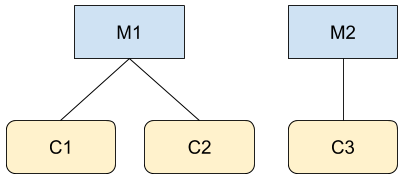Aby wyświetlić listę dostępnych klientów, użyj metody ListAccessibleCustomers w CustomerService. Warto jednak zrozumieć, którzy klienci są zwracani w odpowiedzi tego typu.
Wyświetlenie listy dostępnych klientów to jedno z niewielu żądań w interfejsie Google Ads API, które nie wymaga podawania identyfikatora klienta i ignoruje wszystkie podane identyfikatory login-customer-id.
Powstała lista klientów jest tworzona na podstawie Twoich danych logowania OAuth. Żądanie zwróci listę wszystkich kont, na których możesz podjąć działania bezpośrednio przy obecnych danych logowania. Nie musi to obejmować wszystkich kont w hierarchii konta; będą natomiast uwzględniane tylko konta, do których dodano uwierzytelnionego użytkownika z uprawnieniami administratora lub innymi uprawnieniami na koncie.

Załóżmy, że jesteś użytkownikiem A, który jest administratorem kont M1 i C3 w 2 hierarchiach widocznych na rysunku. Jeśli tworzysz wywołanie interfejsu Google Ads API, na przykład do GoogleAdsService, możesz uzyskać dostęp do informacji o kontachM1 ,C1 ,C2 oraz C3. Jednak wywołanie do CustomerService.ListAccessibleCustomers zwróciłoby tylko M1 i C3, bo tylko na takich kontach użytkownik A ma bezpośredni dostęp.
Oto przykładowy kod, który ilustruje użycie metody CustomerService.ListAccessibleCustomers:
Java
private void runExample(GoogleAdsClient client) { // Optional: Change credentials to use a different refresh token, to retrieve customers // available for a specific user. // // UserCredentials credentials = // UserCredentials.newBuilder() // .setClientId("INSERT_OAUTH_CLIENT_ID") // .setClientSecret("INSERT_OAUTH_CLIENT_SECRET") // .setRefreshToken("INSERT_REFRESH_TOKEN") // .build(); // // client = client.toBuilder().setCredentials(credentials).build(); try (CustomerServiceClient customerService = client.getLatestVersion().createCustomerServiceClient()) { ListAccessibleCustomersResponse response = customerService.listAccessibleCustomers( ListAccessibleCustomersRequest.newBuilder().build()); System.out.printf("Total results: %d%n", response.getResourceNamesCount()); for (String customerResourceName : response.getResourceNamesList()) { System.out.printf("Customer resource name: %s%n", customerResourceName); } } }
C#
public void Run(GoogleAdsClient client) { // Get the CustomerService. CustomerServiceClient customerService = client.GetService(Services.V22.CustomerService); try { // Retrieve the list of customer resources. string[] customerResourceNames = customerService.ListAccessibleCustomers(); // Display the result. foreach (string customerResourceName in customerResourceNames) { Console.WriteLine( $"Found customer with resource name = '{customerResourceName}'."); } } catch (GoogleAdsException e) { Console.WriteLine("Failure:"); Console.WriteLine($"Message: {e.Message}"); Console.WriteLine($"Failure: {e.Failure}"); Console.WriteLine($"Request ID: {e.RequestId}"); throw; } }
PHP
public static function runExample(GoogleAdsClient $googleAdsClient) { $customerServiceClient = $googleAdsClient->getCustomerServiceClient(); // Issues a request for listing all accessible customers. $accessibleCustomers = $customerServiceClient->listAccessibleCustomers(new ListAccessibleCustomersRequest()); print 'Total results: ' . count($accessibleCustomers->getResourceNames()) . PHP_EOL; // Iterates over all accessible customers' resource names and prints them. foreach ($accessibleCustomers->getResourceNames() as $resourceName) { /** @var string $resourceName */ printf("Customer resource name: '%s'%s", $resourceName, PHP_EOL); } }
Python
def main(client: GoogleAdsClient) -> None: customer_service: CustomerServiceClient = client.get_service( "CustomerService" ) accessible_customers: ListAccessibleCustomersResponse = ( customer_service.list_accessible_customers() ) result_total: int = len(accessible_customers.resource_names) print(f"Total results: {result_total}") resource_names: List[str] = accessible_customers.resource_names for resource_name in resource_names: # resource_name is implicitly str print(f'Customer resource name: "{resource_name}"')
Ruby
def list_accessible_customers() # GoogleAdsClient will read a config file from # ENV['HOME']/google_ads_config.rb when called without parameters client = Google::Ads::GoogleAds::GoogleAdsClient.new accessible_customers = client.service.customer.list_accessible_customers().resource_names accessible_customers.each do |resource_name| puts "Customer resource name: #{resource_name}" end end
Perl
sub list_accessible_customers { my ($api_client) = @_; my $list_accessible_customers_response = $api_client->CustomerService()->list_accessible_customers(); printf "Total results: %d.\n", scalar @{$list_accessible_customers_response->{resourceNames}}; foreach my $resource_name (@{$list_accessible_customers_response->{resourceNames}}) { printf "Customer resource name: '%s'.\n", $resource_name; } return 1; }
curl
# Returns the resource names of customers directly accessible by the user # authenticating the call. # # Variables: # API_VERSION, # DEVELOPER_TOKEN, # OAUTH2_ACCESS_TOKEN: # See https://developers.google.com/google-ads/api/rest/auth#request_headers # for details. # curl -f --request GET \ "https://googleads.googleapis.com/v${API_VERSION}/customers:listAccessibleCustomers" \ --header "Content-Type: application/json" \ --header "developer-token: ${DEVELOPER_TOKEN}" \ --header "Authorization: Bearer ${OAUTH2_ACCESS_TOKEN}" \
Wyświetlanie listy anulowanych kont
Interfejs Google Ads API nie udostępnia bezpośredniego sposobu na wyświetlanie listy anulowanych kont na koncie menedżera. Możesz jednak użyć tego obejścia, aby pobrać tę listę.
Pobierz listę linków
ACTIVEza pomocą zasobucustomer_client_linki utwórz listę klientów, korzystając z polacustomer_client_link.client_customer.SELECT customer_client_link.client_customer, customer_client_link.status FROM customer_client_link WHERE customer_client_link.status = ACTIVEPobierz listę kont
ENABLEDza pomocą zasobucustomer_client.SELECT customer_client.id, customer_client.descriptive_name FROM customer_clientRóżnica między tymi 2 listami to lista anulowanych kont.

